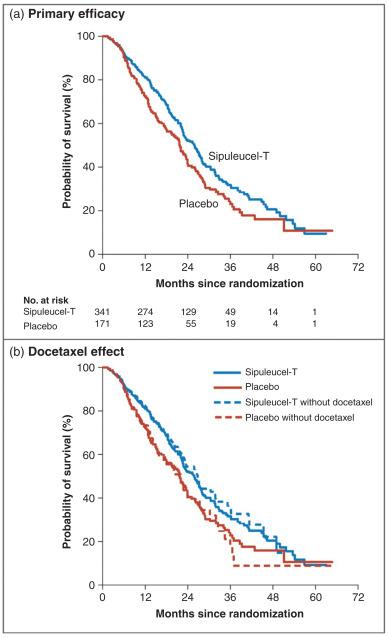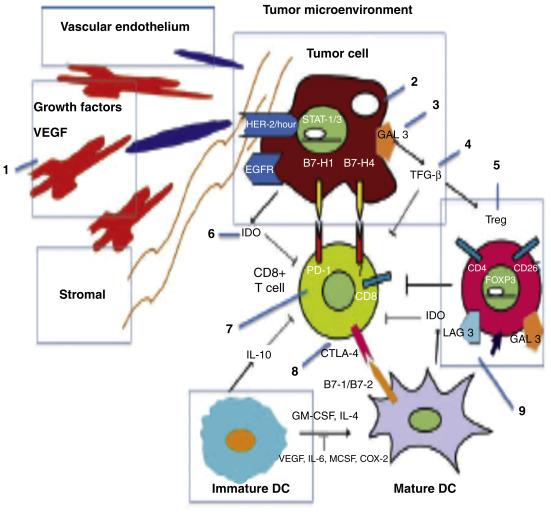Physical Address
304 North Cardinal St.
Dorchester Center, MA 02124
Among five new therapies for patients with metastatic castration-resistant prostate cancer, sipuleucel-T (Provenge ® ) stands out as the first immunotherapy approved by the FDA for asymptomatic or minimally symptomatic castrate metastatic prostate cancer with the added benefit of improvement in overall survival. Its approval was determined by the results of a placebo-controlled, randomized trial (the IMPACT trial), conducted in 512 asymptomatic or minimally symptomatic men with metastatic castration-resistant prostate cancer. Although no difference in time to progression or PSA response rate was reported, a statistically meaningful 4.1-month improvement in median survival was achieved in the active arm with respect to the placebo arm (25.8 months vs. 21.7 months) ( Figure 56.1 ). The survival benefit was comparable to that seen with standard chemotherapy, docetaxel, and now with the new AR-directed agents, enzalutamide (Xtandi ® ) and abiraterone (Zytiga ® ), second-line chemotherapy cabazitaxel (Jevtana ® ), and even radium-223 (Xofigo ® ). While its indication is for patients with asymptomatic or minimally symptomatic castrate metastatic disease, its major endorsement has been its potential broad applicability to all clinical states of the disease, that is, from biochemical relapse postprimary therapy, to castrate nonmetastatic to even postchemotherapy. Overall, the treatment paradigm for treating castrate metastatic prostate cancer has been altered by introducing AR-directed therapies earlier into the treatment scheme and also introducing immune-based therapies not only earlier but later into the treatment arena, that is, with or after chemotherapy or in combination with biologics or other hormonal agents ( Figure 56.2 ).


Immunotherapy has previously been widely tested in many different diseases with a predominance of effort in the hematologic diseases where monoclonal antibodies against cell surface molecules are given either alone or in concert with radiopharmaceuticals. Antibody-radionuclide conjugates have been successfully developed for the treatment of non-Hodgkin’s lymphoma, resulting in the approval of agents that are CD20-targeted: 131 I-tositumomab (Bexxar) and 90 Y-ibritumomab tiuxetan (Zevalin), which can produce response rates of 50–85% in a variety of lymphomas. Sipuleucel-T represented an autologous cellular product vaccine, which mandated that patients be leukapheresed to obtain peripheral blood mononuclear cells followed by a 48-h turnover during which cells were processed, expanded, then incubated with prostatic acid phosphatase (PAP) combined with GM-CSF. The cells were divided into three reinfusions, one given every 2 weeks. Patients were then monitored per clinical practice with imaging and PSAs. Overall, the treatment was well-tolerated with expected transfusion-associated side effects such as fever and chills. Since the FDA approval of sipuleucel-T, additional studies have sought to expand its use and to identify in which patients the greatest clinical benefits may be derived. A retrospective analysis of the IMPACT trial found that patients in the lowest quartile of PSA values derived a greater benefit from sipuleucel-T vaccine with a 13-month improvement in OS (41.3 months with sipuleucel-T compared with 28.3 months with placebo; [HR 0.51; 95% confidence interval (CI) 0.35–0.85)]. However, for those patients in the highest baseline PSA quartile, the median OS was 18.4 compared with 15.6 months for placebo [HR 0.84; 95% CI 0.55–1.29], with an improvement of only 2.8 months. Most of the studies with sipuleucel-T have been largely retrospective and its mechanism of action still controversial. A report by Drake et al. postulated that antigen cascade may be responsible for its mechanism of action; also thought to be a key component of how the vaccine ProstVAC works. Though antibodies to PAP were generated and a robust ki57 proliferative response was induced, suggesting involvement of the adaptive immune response. Additional evaluation of retrospective studies by Drake et al. suggested that OS was enhanced in patients who received sipuleucel-T and had IgG antibody responses to greater than two secondary antigens compared with those patients who did not have antibodies induced. It should be noted that the word “response” should be used within the context of an association of antibody induction with a change in biology of the cancer, that is, clinical outcome, and not the generation of the antibody in response to an immunogen per se.
While sipuleucel-T was met with enthusiasm as the first immunotherapy approved for a solid tumor malignancy, the observation that overall survival was improved in the absence of significant clinical benefit solicited questions as to how the product worked and whether it in fact mediated an antitumor reaction of some sort. Many physicians in the field felt that knowing the mechanism of action was important in being able to build on the treatment, whereas others felt that knowing the mechanism of action made little difference in their use of the drug as long as the drug worked. As such, investigators have sought to identify a biomarker that may indicate that a target has been hit or that the immune system has been stimulated. Because of the mixed cellular nature of the autologous mononuclear cell product, it was unclear as to the nature of the effector population that may have been relevant in inducing a potential antitumor effect, and ultimately survival. Other than T cell proliferation assays, no one cellular marker was indicative of the drug inducing immunogenicity. The working premise has always been that the cellular product was enriched with antigen presenting cells (APC.) This was confirmed by the observation by flow cytometry that CD54 + cells were responsible for antigen uptake and that CD54 + cells harbored the PAP-specific antigen presentation activity as assayed using a PAP-specific HLA-DRβ1-restricted T cell hydridoma. The marker CD54 or intracellular adhesion molecule-1 (ICAM-1) serves as a ligand for the CD11a/CD18 (LFA-1) leukocyte integrin complex and its interaction with other cell types is thought to be relevant in its role as a potential costimulatory receptor. In the setting of sipuleucel-T, the fusion protein, PA2024, comprised of PAP fused to GM-CSF, was used as the immunogen, with the PAP portion of the molecule providing the necessary immunogenicity and the GM-CSF serving to activate the APC. Studies confirmed that the isolated CD54 + cells took up antigen as well as presented and processed the antigen in an MHC-restricted manner. Similar results were obtained with an HLA-DRβ1 restricted T cell hybridoma specific for a different PAP-derived peptide. These findings provided some insight to how the product might work in vivo but still required validation.
The opportunity to further validate the earlier role of CD54 + cells was provided by the availability of cellular products from three phase III double-blind placebo-controlled trials in patients with metastatic CRPC including the IMPACT trial, which led to the product’s FDA approval. Patients were randomized 2:1 in favor of sipuleucel-T or to control. This included a minimum of at least one treatment with the cellular product as well as additional information provided from the product prepared at the primary manufacturing facility in Seattle, Washington. APC number, ACP activation, and total nucleated cells (TNC) were assessed in the control and investigational product. Also assessed were T cell proliferation and interferon-γ secretion by ELISPOT at treatment weeks 0, 2, and 4 in the IMPACT trial. In the three trials, ex vivo APC activation was greater with sipuleucel-T relative to the control at weeks 0, 2, and 4 with the median APC activation increased approximately 6.2-fold. The median cumulative APC activation with sipuleucel-T alone across the three dose preparations was 26.7 [21.5, 33.6]. Elevated levels of T-cell activation-associated cytokines were noted during manufacture but not induced prior to and after exposure to GM-CSF alone. The treatment generated PA2024- and/or PAP-specific humoral responses in 68% (102/151) of patients compared with 3% (2/27) of control patients. The anti-PA2024 and anti-PAP antibody titers were greater in the sipuleucel-T arm compared with controls at all time points posttherapy, and a persistent response detectable after 26 weeks following initial posttreatment baseline. It should be noted that overall product activation was confirmed by TH 1 cytokines (IFN-γ, TNF-α); TH2 cytokines (IL-5, IL-13) were also present implying that TH 1 and TH 2 cells were activated in an antigen-specific manner. IL-10 was less detectable relative to those cytokines that facilitate T cell expansion such as IL-2, IFN-γ, and TNF-α. There also appeared to be a correlation between overall survival and T cell secretion of IFN-γ by ELISPOT and PA2024-specific antibody.
Become a Clinical Tree membership for Full access and enjoy Unlimited articles
If you are a member. Log in here